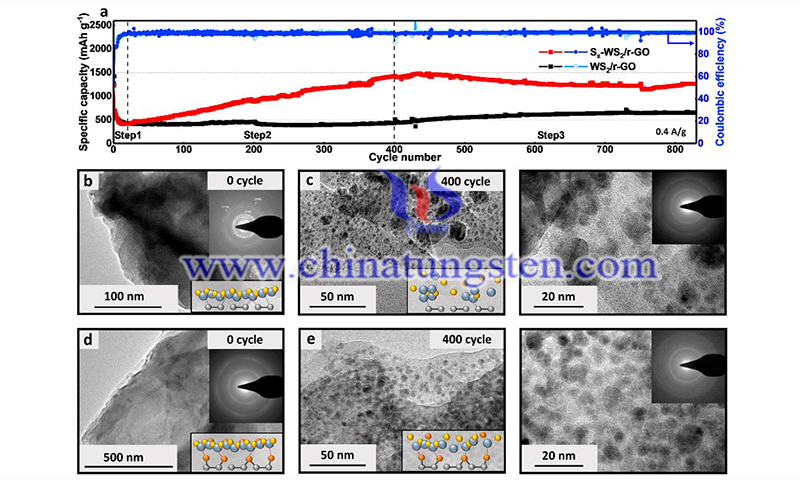Tungsten Disulfide in Applications of Sodium-Ion Batteries
- Details
- Category: Tungsten Information
- Published on Monday, 05 September 2022 22:15
Tungsten disulfide possesses a much larger interlayer spacing of 0.62 nm than that of graphite (0.34 nm). This would be very favorable for the reversible process of Na+ intercalation/de-intercalation, making WS2 a promising anode material for sodium-ion batteries (SIBs). For example, Liu et al. reported WS2 nanowires (NWs) with an expanded interlayer spacing of 0.83 nm.
When applied to SIBs, WS2 NWs exhibited an extraordinary capacity of 605.3 mAh.g-1 at a current density of 100 mA.g-1, while retaining only 483.2 mAh.g-1 after 50 cycles, showing poor cycling stability. Similar to LIB, suboptimal cycling stability is one of the factors limiting the application of WS2 in SIBs.

(Picture source: Uijin Chang/ ACS Appl. Mater. Interfaces)
Sodium-ion batteries (SIBs) are considered a potential alternative to LIBs and have been extensively studied recently due to the low cost and abundance of sodium sources. However, the relative atomic mass of sodium is larger than that of lithium, resulting in a smaller theoretical specific capacity. Therefore, improving the storage capacity of sodium ions is an urgent task in studying the anode materials for SIBs.
To overcome this problem, a facile approach is to tailor tungsten disulfide with different crystalline nanostructures. For example, Wang et al. prepared (002)-oriented WS2 nanosheets, which exhibited 85% enhanced retention of WS2 electrodes after 100 cycles at a current density of 100 mA.g-1 compared to (100)-oriented WS2 due to the wide (002)-oriented crystal interlayer spacing and high crystallinity.
Another strategy is to combine WS2 with carbonaceous matrix materials (graphene, carbon nanotubes, and amorphous carbon) to buffer the large volume changes during Na+ intercalation/delamination. For example, Su et al. investigated WS2-graphene nanocomposites in NIB and found good cyclability and electrochemical properties. In addition, WS2 nanoplates embedded with graphitic carbon nanotubes were synthesized by Kong et al.
Benefiting from the confined growth of WS2 nanoplates and unique interconnected graphitic carbon nanostructures, composites with nanoscale WS2 dispersion not only possess better conductivity and electrolyte accessibility arrangements but also effectively buffer the volume change during cycling. In addition, Super P is a promising anode material considering the cost. Li et al. prepared WS2/Super P composites showing high reversible sodium and lithium storage capacity of 270 mAh.g-1 at a current density of 100 mA.g-1 and 322 mAh.g-1 at 200 mA.g-1 after 100 cycles. storage capacity.

(Picture source: Uijin Chang/ ACS Appl. Mater. Interfaces)
In summary, WS2 nanomaterials have made some progress in the application of lithium-ion and sodium-ion batteries. However, when used as battery anodes, WS2 nanomaterials have the disadvantages of low electrical conductivity and poor cycling stability, so combining with carbon matrix materials is a widely adopted approach.
Supercapacitors are a class of electrochemical energy storage devices widely used in hybrid vehicles, new energy harvesting and conversion, and mobile electronic devices. The electrode materials for supercapacitors require an effective and controllable porous structure, specific surface area, and good electrical conductivity. Supercapacitors can be divided into two categories: electric double-layer capacitors (EDLC) and pseudocapacitors (PC).
The former relies on reversible adsorption and desorption of ions on the electrode surface to store electrons; the latter reserves electrons through pseudo-capacitance processes (including underpotential deposition, rapid redox reactions, and rapid insertion and deintercalation of non-phase change ions) that occur on the electrode surface. Together with other TMDCs, WS2 can be a promising candidate for supercapacitor applications, depending on its unique structural and electrical properties.
According to the current study, there are two strategies to improve the performance of its capacitors. One approach is to design and fabricate nanostructures with suitable methods to increase the surface area of WS2. To explore the effect of WS2 morphology on its supercapacitor performance, numerous experiments have been conducted. Ansari et al. prepared porous WS2 (P-WS2) consisting of several layers of nanosheets, which exhibited a high specific capacity of 292 mAh-g-1 at a current density of 0.2 °C and 100 cycles with good cycling stability.
Article Source: Sun, CB., Zhong, YW., Fu, WJ. et al. Tungsten disulfide nanomaterials for energy conversion and storage. Tungsten 2, 109–133 (2020).
- Tungsten Manufacturer & Supplier, Chinatungsten Online: www.chinatungsten.com
- Tungsten News & Prices of China Tungsten Industry Association: www.ctia.com.cn
- Molybdenum News & Price: news.molybdenum.com.cn
- Tel.: 86 592 5129696; Fax: 86 592 5129797; Email: sales@chinatungsten.com



 sales@chinatungsten.com
sales@chinatungsten.com